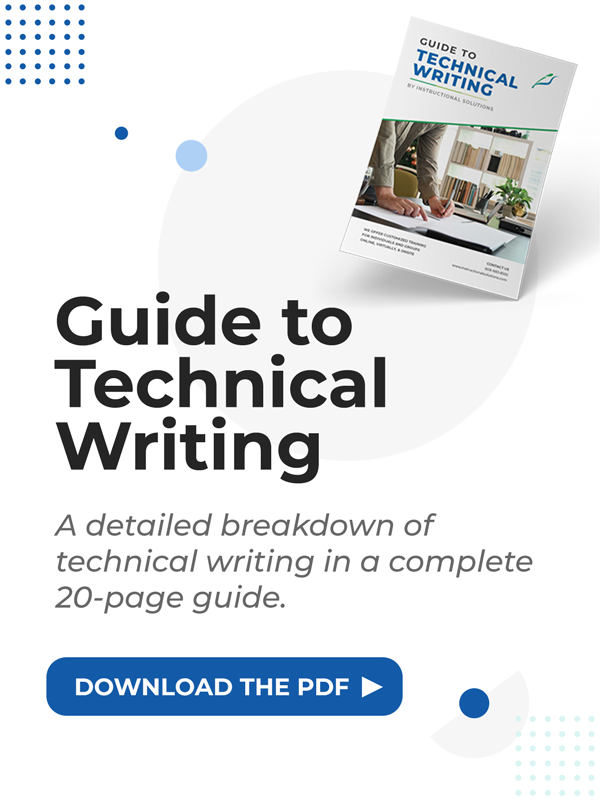What Is Policy Writing And How Do I Write Policy Documents? Tips & Examples

Originally published August 4, 2022, updated October 28, 2025

Table of Contents
So, you've been tasked with writing a policy for your company. Policy writing can sometimes feel unnecessary; oftentimes the specific rules and requirements you're explaining seem intuitive.
But policies answer important questions and ensure safety and best practices are understood in daily organization operations and activities.
As you write the policy, remember your reader and write to meet their needs.
- Keep it short. You can still write detailed descriptions, but make it as concise as possible.
- Be specific. Spell out who the policy applies to.
- Use a standardized format. Make sure to incorporate headings and bullets.
- Edit and review for accuracy.
Let's first look at the definition of policy writing. We then break down the policy development process into five key steps.
What is policy writing?
Policy writing is creating a type of technical document that presents a set of guidelines or rules (hint: it's NOT a how-to document for following the rules -- that's a procedure that can be part of a policy). Policies should be:
- Concise and easy to understand.
- Factual and accurate.
- Living documents (policies need to be updated periodically).
Why is Policy Writing Important?
1. Creating Organizational Clarity
Well-crafted policies eliminate ambiguity by setting clear expectations and boundaries. They answer key questions in advance: What behaviors are acceptable? How should conflicts be resolved? What standards must be upheld? This clarity reduces confusion, minimizes miscommunication, and empowers employees to make confident decisions.
2. Ensuring Fair and Consistent Treatment
Policies create a level playing field by applying uniform standards to everyone. Whether addressing performance, resource allocation, or workplace conduct, consistent policies prevent favoritism and arbitrary decision-making. This fairness builds trust, boosts morale, and fosters an equitable work environment.
3. Providing Legal and Regulatory Protection
Policies serve as a defense mechanism. They demonstrate compliance, document due diligence, and provide evidence of good faith. During audits, investigations, or legal disputes, well-documented policies protect organizational interests.
4. Enhancing Operational Efficiency
Clear policies streamline decision-making by offering ready frameworks for recurring situations. Employees can act quickly without waiting for approvals, reducing delays and administrative burdens. This efficiency frees leadership to focus on strategic priorities.
5. Establishing Accountability Frameworks
Policies define responsibilities, authority, and consequences for compliance or violations. This accountability structure promotes professionalism, strengthens performance management, and ensures both achievements and failures are addressed appropriately.
6. Implementing Risk Management
Organizations face risks ranging from financial to reputational. Policies act as preventive measures: cybersecurity policies guard data, while safety policies reduce liability. By anticipating problems, they minimize costly mistakes.
7. Shaping Organizational Culture
Policies communicate values and priorities. A professional development policy signals investment in growth, while an ethics policy demonstrates integrity. They shape identity and reflect what the company stands for.
8. Supporting Scalable Growth
As organizations evolve, policies provide structural stability. They preserve quality and culture while enabling adaptation to new laws, technologies, and best practices, ensuring sustainable growth.
Types of Policies
Policies serve as guiding principles that help organizations, governments, and individuals make consistent and well-informed decisions. They provide direction, ensure accountability, and maintain order within systems. The audience or reader of a policy usually depends on its type and purpose. Here are four types of common policies:
- Public Policy: These are developed and implemented by governments to address societal issues, promote welfare, and regulate public behavior. Examples include education, healthcare, and environmental policies.
- Organizational or Company Policy: These policies are developed within businesses or institutions to guide employee behavior, ensure compliance, and align actions with organizational goals. They promote fairness, consistency, and efficiency, while also supporting the company’s values, culture, and legal obligations across all levels of the organization.
- Functional Policy: Functional policies focus on specific departments or areas, such as finance, marketing, or human resources. They provide clear guidelines, streamline processes, and ensure that each function operates efficiently, contributing effectively to the overall objectives and smooth functioning of the organization as a whole.
- Specific Policy: Specific policies address particular needs or situations, such as insurance, safety, or data protection. They set clear standards, rules, and procedures to manage risks, provide clarity, and ensure consistent decision-making, enabling effective implementation in well-defined contexts.
Write two technical documents and get instructor feedback.
In our Technical Writing Foundations course, you will write a procedures document and a one-page report and receive detailed feedback from your instructor.
Download the OutlineHow To Write a Policy - 5 Steps of Effective Policy Writing
Organizations and companies can have many policies. For example, say that your company has an overall company policy that includes rules for employee code of conduct, workplace health and safety, and the dress code.
Your marketing department has a separate policy that outlines rules for gift-giving. Your finance department might have a policy detailing financial employees' roles and responsibilities. Overlapping policies should have consistent language and requirements.
Strong policy writers are crucial to ensuring that policies are effective and consistent. Here's how to do just that.
Step 1: Plan your policy
Maybe you have more than one policy to write (companies like Coca-Cola have an entire library of policies!). Create a timeline for when you'll plan, draft, and revise each one. Select one policy to get started. Next, a major part of the policy process is planning before drafting. Planning the content first is crucial for efficiency and effectiveness.
For example, how are current processes completed? What do day-to-day tasks look like? Do other policies already exist that would impact this one? Are there any regulations or accreditation standards? This information will impact the amount of detail you include and more!
Step 2: Structure the content & ask for input
Once you've analyzed your audience and purpose, map out your policy's content. What information will you include? What are your main points? Your subpoints? How will you organize the sections? Creating an outline or concept map can help get your ideas on paper and speed up the actual writing process.
The structure or the organization of the sections will depend on the policy type. Below is an example structure for an accident reporting company policy:
- Policy brief & purpose
- Scope (who the policy affects)
- Policy elements (what should be reported)
- Procedure for reporting
- Disciplinary consequences
An anti-bribery policy's structure might be set up similarly, but the sequence of the sections could change:
- Policy summary
- Purpose and goals of the policy
- Risk and/or consequences of non-compliance
- Scope and range of application
- Policy details (e.g., applicable laws)
Select a policy structure that makes the most logical sense for the reader. It can be helpful to use a template or review other company examples. However, use your audience and policy's purpose as your document's North Star. Make sure your writing process drives the template -- not the other way around.
As you set up your policy's structure, ask for input from others on the policy team. Collaborate on the structure and overall content now so you don't have to rearrange or revise extensively later on.
Step 3: Write the policy
Use your detailed content plan to draft the actual policy. As you write the document, remember that your reader is the center of the action. Write to meet their needs and enhance their understanding.
Here are a few tips for creating a reader-focused policy:
- Keep it short. Policies are already complex. You can still write detailed descriptions, but take the time to make the document as concise and clear as possible. This helps with reader understanding.
- Be specific about who does what. It might seem intuitive, but spell out who the policy applies to (e.g., all employees). Also, break down the responsibilities and duties of different employees, departments, etc., if applicable.
- Use precise words and short sentences. No need to use fancy words in a policy. Write in easy-to-understand language and short sentences.
- Write in the active voice. Active is more engaging than passive voice. In active voice, the subject of the sentence is the doer of the action (e.g., "all employees must adhere to these steps"). In passive voice, the subject of the sentence is what's being acted upon (e.g., "these steps must be adhered to by all employees").
- Ensure visuals are easy to understand. If your policy includes visuals such as graphics or tables, ensure that they make sense. Also, make sure they aren't blurry and are appropriately labeled.
- Follow a style guide. A style guide helps you write in a particular style. It provides a set of standards or writing rules/recommendations for the tone, grammar, and structure of a technical document. If your company doesn't already follow a particular one (e.g., AP Stylebook), here's a list of technical writing style guides to consider.
- Cut the jargon. You might have a technical background and understand certain terms, but your reader might not. Avoid jargon and spell out terms and meanings.
Step 4: Use a standardized format.
Policy standardization ensures consistency across company policies. Typically, the format should include:
- The correct logo and brand colors.
- Policy name and number.
- A legal disclaimer in the policy's footer.
It can help to create a format template to follow for all policies. Whatever format you follow, make sure to incorporate headings and bullets. These elements help the reader skim and easily digest the information.
Step 5: Edit and review for accuracy.
Once you've written your policy, it's time to edit.
Edit the substance first. Put yourself in the reader's shoes and ask yourself: Is the information accurate? Is it easy to understand? Does the structure make logical sense for the reader? Finally, correct sentence structure and grammar.
It also helps to get another pair of eyes on the policy. Have your policy team or peers also review for any mistakes and clarity. Ask a subject matter expert to also review if necessary.
After thoroughly editing the document, submit the final draft to the appropriate manager or supervisor for the final sign-off.
Policy Writing Examples
No matter what type of policy you're writing, it can be helpful to review examples. Here are a few policy writing examples that demonstrate best practices.
1. MasterCard Code of Conduct
A code of conduct is a policy that outlines expected behavior standards for all employees. MasterCard's code of conduct uses clear visuals, simple language, and a logical structure to present these standards to the company.
2. Intel Environmental, Health, and Safety Policy
This type of policy outlines a company's commitment to meet work health and safety laws. It shows how employees are protected in the workplace.
Intel's environmental, health, and safety policy is neatly formatted with headings and the company colors/logo. The language is simple overall and maps out how the company is adhering to specific principles.
3. Gordon State College Teleworking Policy
As working from home continues to become the norm, companies need to create policies that detail what's acceptable for employees working out of the office.
Simple yet effective, Gordon State College's teleworking policy includes the purpose of the document and clear definitions of eligible employees, positions, office hours, etc.
Hint: Sentences in the policy should include only one space after a period instead of two.
Strengthen your Policy Writing Skills
Even after your policy is written, don’t let it become stagnant. Set up a regular review (e.g., every year or every six months) on your calendar to ensure you stay current with new laws, regulations, and best practices.
Improve your policy process and create more effective, compliant policies by enrolling in a technical writing course. At Instructional Solutions, our online courses provide comprehensive lessons, practical exercises, and individualized feedback to help both new and experienced policy writers. Learners gain actionable strategies to draft policies faster, maintain consistency, and keep documents up to date. No matter your assignment, Instructional Solutions equips you with the skills to take a structured, technical approach and confidently produce successful, professional policies.
Conclusion
In the end, strong policy writing is more than just documenting rules—it creates clarity, consistency, and accountability that guide an organization’s daily operations. Clear policies ensure employees understand expectations, managers make fair decisions, and the company remains protected against risks and legal issues. They also improve efficiency, shape culture, and provide the foundation for sustainable growth.
As businesses expand and adapt to new challenges, well-written policies act as living documents that evolve with regulations, technologies, and workplace trends. A good policy keeps organizations steady while supporting long-term goals. In short, effective policies are strategic assets that help organizations grow.
Get Instructor Feedback on Your Actual Technical Writing
Our online self-paced course will teach you how to write any technical document well.
FAQs
1. What are the common mistakes in policy writing?
Common mistakes in writing policy include using overly complex language, creating policies that are too vague or too restrictive, failing to involve stakeholders in development, and neglecting regular updates to reflect changing circumstances.
2. Can I customize a policy template?
Yes, templates should be customized to reflect your organization's specific needs, culture, industry requirements, legal obligations, and operational realities. Generic templates are starting points, not final solutions.
3. How do I write clear and effective policies?
To write clear and effective policies, use simple, direct language, define key terms, organize content logically, include specific examples, involve relevant stakeholders in development, and ensure policies are easily accessible and regularly communicated.
4. What are the key components of a policy?
The key components of a policy include a purpose statement, scope of application, definitions of key terms, roles and responsibilities, compliance procedures, consequences for violations etc.
5. Should policies be formal or informal?
Policies should generally be formal documents with consistent formatting, official approval processes, and documented review cycles. However, the language should be accessible and the tone appropriate for your organizational culture.


